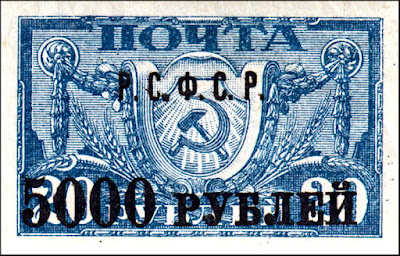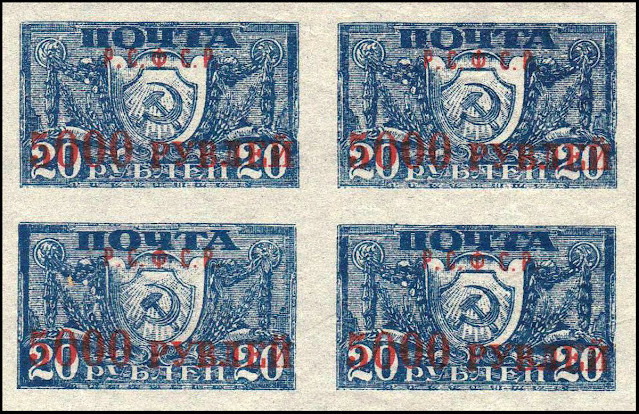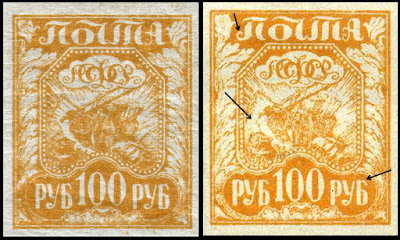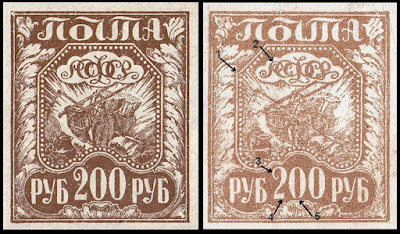 |
| RSFSR in red |
socialist state from 1917 to 1922, and afterwards the largest and most populous of the Soviet socialist republics of the Soviet Union.
Many of the early lithographed stamps of the RSFSR have been forged and widely distributed.
The troubled times were a good opportunity for forgers to fill the demand in Europe.
As the originals are fairly inexpensive and often poorly printed, forging them without being detected was fairly simple.
As the originals are fairly inexpensive and often poorly printed, forging them without being detected was fairly simple.
1918, November 7
The first revolutionary issue of the postage stamps of RSFSR.
Designed by R.Zarrinsh, engraved by P.Xidias.
Typographed on white paper, vertical lozenges, varnish on face, comb perf 13.5
 |
| Original issues |
 |
| Color trial value |
 |
| Color Essays |
Forgeries
2 possibly from different sources are noted
I have not been able to find an actual sample forgery
Aside from the features noted above
There are 3 noted forgeries that are not usually seen outside of Russia
Two have very rough perfs 13.5, the original has clean 13.5 perfs
The designs are lacking many details
 |
| Image from period catalog |
The above 3rd. forgery is considered dangerous. It is found in pale blue and all the angles in the letters tend to be rounded and all thin frame lines show numerous breaks.
Aside from the features above
The perfs are 11.5 instead of 13.5
1918 Ruble Arms type Issues
A hasty reprint of stamps from the existing plates Arms type stamps was carried out early in 1918. They can be distinguished with difficulty from the earlier printings by the worn plates used in conjunction with generally rough 12.5 perforations and the shades of printing inks used. These stamps were not immediately distributed to all post offices but only those near enough to receive supplies and then only when existing stocks were exhausted or near depletion.
They can be found with centers omitted , severely shifted or inverted, double prints, pairs with differences and a host of perforation errors.
 |
| 1918 reprint |
Few forgeries exist with the main one being the 1O k. imperf shown above
The diagram indicates the features of the forgery on the right.
1921, Aug.-Sept.
The RSFSR's first definitive issue of stamps had been designed and ordered, with values from 1R. to 1000R. probably some time in 1920.
The lithographic designers were V.Kupriyanov, 1R, 2R, 20R, 100R, 200R and 300R and G. Reindorf, 5R, 250R, 500R and 1000R.
According to the 1924 Chuchin Catalogue, the quantities delivered to the Post Offices were:-
1 R. 399,400,
2 R. 398,450,
5 R. 543,330,
20 R. 289,760,
40 R. 174,980.
1 Ruble
 |
| Color Proof |
Genuine left, forgery right
1. The ends do not cross
2. The curl is not as curved
3. The letters are thicker
4. The tip of the 1 is not as curved
5. The P is closed not open as in the genuine
6. The b shape is closed
Overall the color is duller and details are not as sharp
The right forgery has the same features as the 1 Ruble
2 Rubles
Note the dots around the inner frame are smaller
The side features are particularly lacking details on the left side
The main differences are again with the letters
5 Rubles
 |
| Proof |
The main differences are again with the letters
1. The opening on the P is smaller
2. The b shape letter has a flat bottom rather than rounded as with the genuine
3. The curved tail extends lower
4. Key point - no accent over the letter. This may be the case that the forgery was made out of the country and the forger was unaware of the Russian alphabet.
5. The small leaf and nut are missing - SEE BELOW
One that has a notch in the top left corner and missing leaf/nut as in the above comparison and one that does not have these forgery features
20 Rubles
The O is above the other letters
The crossbar of the Y is not slanted
Very dark area and no line in the crescent
Three lines in the sickle as in the original
No horns on the T
Thick left leg on the A
Genuine 39 x 23.5 mm. Forgeries 37 .5 x 22.5 mm.
The O and A are above the other letters
The crossbar of the Y is not slanted
Very dark area and no line in the crescent
Two lines in the sickle
No horns on the T
The right side of the T is thicker
Thick left leg on the A
Genuine 39 x 23.5 mm. Forgeries 37 .5 x 22.5 mm.
NOTE - all the forgeries tend to have thicker less defined features
The top right one is a Forgery Type I the others Type II
It is generally accepted that any overprint on a forgery is fake.
 |
| Genuine stamp and overprint |
40 Rubles
It has generally been considered that there are no forgeries of the 40 R. value
The 2nd series
The hasty production and distribution of these higher value stamps to meet the inflationary demands of the increased postal rates resulted in a wide range of different papers used.
Quantities issued
100 R 44,391,900
200 R 4,000,000
250 R 78,929,150
300 R 3,000,000
500 R 1,071,900 - this value is noticeably harder to find copies
1000 R 53,869,950
 |
| Genuine stamps |
 |
| Proofs |
100 Rubles
 |
| Color varieties |
Forgery
The curl in the first letter points right rather than downwards
The last letter bottom right lacks the spur but intead id slightly dented
Overall fine details are lacking especially left of the center
1. The corner has a shoulder
200 Rubles
 |
| Genuine dark brown |
Forgery
2. The inside loop is complete but only partial in the genuine
3. The inside curl on the 2 is cut short
4. The base of the 2 is shorter
5. The bottom of the 0 is open
As with the other forgeries the printing is very rough and details are missing
250 Rubles
 |
| Proof |
 |
| Genuine block with inverted stamps |
Forgery
1. The top of the P is slanted
2. The script is blotchy
3. The indentation inside the 2 bottom stops short
4. The top of the 5 is rounded and the side is malformed.
 |
| Genuine overprint left and right fake on forgery |
2. Dots are uneven
3. b shape has no upper right protrusion
4. Curl of tail is incomplete
5. Bottom of b shape slopes
Lots of side details missing
The details on the 500 Kon forgery are much better than the previous values
500 Rubles
1. Key feature - the s loop is over the one underneath, in the original it is under it
2. The color notch is missing in the elbow
3. The lines in the hammerhead do not match, one line separates the head in two
4. This line is generally broken up in the forgery
 |
| Setoff example |
1. The loop of the first letter is incomplete
2. As with the 500 the position of the loops over/under are reversed
3. The A and the loop tail are joined
4. The lines in the hammer are thicker and longer
5. The lines in the anvil are broken and uneven
1921 Commemorative Issue
The first R.S.F.S.R. Commemorative stamp issue was on November 5th 1921 , to commemorate the 4th anniversary of the October Revolution.
A set of four values in the same design were prepared but only three values were issued the 100 R, 250 R and 1,000 R.
The stamps were lithographed from a design by A. Lybovichem and printed in panes of 25 stamps in a 5x5 layout on sheetlets of 50 stamps.
White, dull grey, pale cream and brownish papers were used
 |
| Original set |
Forgeries
There appears to be 2 types of forgeries or 1 is a sub-type.
The forgery has a lot of broken lines
The top frame line is sparse
Note in particular the top P, dense rays from the star on the left side give it a 3D appearance
The star is lopsided
The top P does not have the shading on the left side
Note the small lines that make up the side frames, unlike the original and previous forgery they are poorly aligned.
NOTE - the 200R is very rare and the Russian listing has it at 50X++ the CV of others in the series. Only copies certified by a Russian noted expert should be accepted
7500R
The 1922 Definitive Issue
A definitive issue was designed and prepared for issue to accommodate the February 1st. postal rate rises but it was not completed for issue until March 4th. for the 7,500R. and 22,500R. values and sometime in April, for the 5,000R. and 10,000R. values.
A 50,000R. value was prepared but never issued, and eventually sold to collectors through the Soviet Stamp Bureaux along with proofs of all the values in other than the issued colors.
The printing control was good and the few varieties are scarce
Quantities issued
5000R - 5,060,500
7500R - 84,643,100
10,000R - 1,000,000
22,500R - 3,000,000
 |
| Light blue variety |
I have not seen mention of forgeries of this issue other than the numerous fake overprints.
I have found the one forgery of a 7500R
The key features are the top letters with the white shadow around them and the distinct inclination to the left.
1922 November
Transports
This issue had no printed values.
It sold for 25R of which 20R was for postage and 5R for charity to combat the famine.
The originals are printed on yellowish or grayish paper, the forgeries on white paper.
Each forgery has specific minor details but the general feature is a lack of fine details clearly evident in the following comparisons with the genuine (left)
The forgeries were probably printed in Germany and are scarce.
Below genuine left, forgery right
I suspect the above are modern facsimiles.
1922 November
This issue was to commemorate the 5th anniversary of the October 1917 revolution
 |
| Designer artwork signed by the artist Dubasov |
Forgeries
These tend to be scarce
A main feature is the larger size of 25.4X20.8 versus 24.8X20.0 for the genuine
2. The chisel is larger
3. The curved pleat is cut short
4. The frame line crosses over the foot
5. The 5 is larger and shaped differently
1922 November
The first airmail of the RSFSR was issued
The design of the previous 45R was used with a red plane overprint superimposed by lithography.
Varieties and errors are scarce.
The printing quantity was small (100,000) so we have a higher CV for originals and used ones are scarce
Forgeries
Forgeries are very plentiful and finding a genuine stamp is difficult.
One of the forgeries is well done but the background is printed in lime green which is easily spotted and it is shown below.
NOTE - the basic 45R with a green background was not issued so we have a case of full forgeries
2. The wing attachment is rounded instead of being flat
3. The tail plane is off center
4. The frame lines are thick
Most of the RSFR forgeries (fakes) are overprints and some have many varieties. It is beyond the scope of this blog to go into them with the sparse details available




































Another excellent blog.I have some forgeries of the 2nf 1921 series that came from a collection purchased at a stamp fair. Most are labeled Vienna Forgeries and have the characteristics of the ones that you describe. In addition there is a 300 r that is labelled Paris forgery - do you have any information about this? Sorry but i cant work out how to include an image.
ReplyDelete